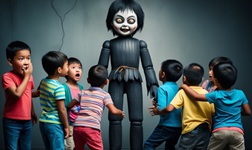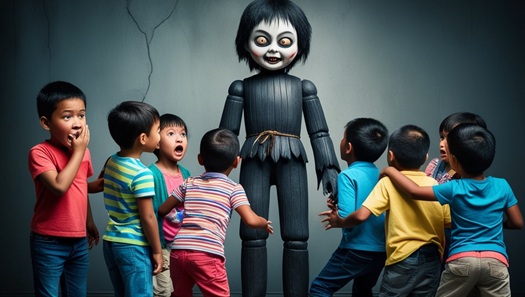Are Labubu Dolls Bad Omens for Kids? Myth Busted

Are Labubu Dolls Bad Omens for Kids? Myth Busted
Introduction
Do Labubu dolls, with their sharp teeth and mischievous grins, bring bad luck to children? This Labubu dolls bad omen myth has sparked worry among parents, fueled by the doll’s eerie design and viral social media tales. Let’s dive into the origins of this misconception, explore its cultural roots, and debunk it with science to show why these quirky collectibles are harmless fun. Join us at omnimyths.com to uncover the truth behind this spooky toy tale!
Origins of the Labubu Bad Omen Myth
Where did the idea that Labubu dolls are bad omens for kids come from? This myth ties to cultural fears and modern trends.
Social Media and Viral Stories
The Labubu bad omen myth gained traction on platforms like TikTok and X, where users shared creepy stories about the dolls causing misfortune or unease in kids. Posts from 2024, when Labubu’s popularity soared (Pop Mart reported $423M in revenue), linked its “ugly-cute” design to bad vibes. These anecdotes, though unverified, spread fast online (University of Southern California, 2023).
Cultural Fears of Creepy Objects
Historically, unsettling objects like dolls have sparked superstition. In the 19th century, Europe saw “haunted” doll tales, and today’s creepy toy myths echo those fears. Labubu’s wild eyes and toothy grin tap into this unease, making it a prime target for bad omen claims (British Museum, 2021).
Cultural Variations of the Myth
The Labubu bad omen myth varies across cultures, shaped by local beliefs about toys and omens.

Western Perspectives
In the U.S., parents often worry about “scary” toys affecting kids’ sleep or behavior, with some linking Labubu’s design to bad luck, similar to fears about horror movie dolls like Chucky. Yet, collectors embrace its quirky charm, showing a split in perception. This reflects a broader Western fascination with creepy toy myths (Yale University, 2022).
Asian Cultural Views
In Hong Kong and China, where Labubu was created by artist Kasing Lung, some traditionalists view its monstrous look as inauspicious, especially for kids, due to superstitions about “evil” appearances. However, urban fans see it as a playful art piece, highlighting a cultural divide (Peking University, 2021).
African Contexts
In parts of Africa, like Nigeria, toys resembling spirits or monsters can be seen as bad omens, tied to ancestral beliefs. While Labubu isn’t widespread, its eerie design could spark similar fears in traditional communities, unlike modern ones embracing global pop culture (University of Lagos, 2020).
Symbolic Meanings of the Myth
Why does the Labubu bad omen myth resonate? It carries deeper cultural and psychological meanings.
Fear of the “Other”
Labubu’s unusual design—part monster, part cute—taps into a fear of things that don’t fit neatly into “good” or “bad.” This “otherness” makes it a scapegoat for misfortune, especially for kids, who are seen as vulnerable (University of Chicago, 2020).
Parental Protection Instincts
The myth reflects parents’ instinct to shield kids from harm. Labubu child safety concerns arise from its creepy aesthetic, which some fear could scare or influence young minds, even without evidence.
Modern Interpretations of Labubu
Labubu’s rise as a global collectible has shaped how this myth is viewed today.
Pop Culture Phenomenon
Endorsed by stars like BLACKPINK’s Lisa, Labubu is a pop culture hit, with fans on Instagram and TikTok celebrating its unique vibe. Yet, its creepy look fuels collectible superstitions, with some parents warning against gifting it to kids (Forbes, 2024).
Media and Online Buzz
Viral X posts and YouTube videos amplify the Labubu bad omen myth, with creators sharing spooky tales for clicks. Meanwhile, toy blogs like Toy Insider praise Labubu’s playful design, showing a divide between fear and fandom.
Debunking the Labubu Bad Omen Myth
No Evidence of Harm
No studies link Labubu dolls to bad luck or negative effects on kids. Psychological research shows toys, even creepy ones, don’t cause misfortune—bad luck is often just coincidence (Stanford University, 2022). The myth stems from superstition, not fact.
Design is Intentional Art
Labubu, inspired by Kasing Lung’s Nordic monster folklore, is meant to be whimsical, not harmful. Its “creepy-cute” aesthetic is a deliberate art choice, not a sign of evil (Hong Kong Arts Centre, 2023). Kids often find it fun, not scary.
Psychological Roots of Fear
The myth ties to creepy toy myths and the “uncanny valley,” where human-like objects seem eerie. Studies show this unease is normal but doesn’t mean Labubu is a bad omen—it’s just our brains reacting to its odd look (MIT, 2021).
Supporting Safe Play with Labubu
Choosing Age-Appropriate Toys
- Check age ratings: Labubu is suitable for kids 3+ per Pop Mart guidelines.
- Talk to kids: Ask if the doll’s look bothers them; most find it cute.
- Supervise play: Ensure younger kids don’t chew small parts.
These steps ensure Labubu child safety (American Academy of Pediatrics, 2022).
Addressing Superstitions
- Educate on myths: Explain that bad luck isn’t caused by objects.
- Focus on fun: Highlight Labubu’s playful, artistic side.
- Open dialogue: Let kids share feelings about toys without fear.
This helps parents move past collectible superstitions.
Conclusion
The Labubu bad omen myth thrives on its creepy-cute design and cultural fears, but science and art prove it’s just a fun collectible. From social media hype to global superstitions, this myth doesn’t hold up. Let’s embrace Labubu’s quirky charm and ditch the spooky rumors. Explore more myths at omnimyths.com!
Frequently Asked Questions
Q: Why do some think Labubu dolls are bad omens for kids?
A: The Labubu bad omen myth comes from its eerie design and social media tales, but no evidence shows it causes harm.
Q: How does Labubu’s design fuel the bad omen myth?
A: Its creepy-cute look triggers the “uncanny valley,” sparking creepy toy myths, though it’s just artistic, not harmful.
Q: What’s the difference between Labubu myths and reality?
A: Myths claim Labubu brings bad luck; reality shows it’s a safe, playful toy designed for fun (Hong Kong Arts Centre, 2023).
Q: How can parents ensure Labubu is safe for kids?
A: Check age ratings, talk to kids about the doll, and supervise play to ensure Labubu child safety.
Q: Why do creepy toy myths like Labubu’s persist?
A: Collectible superstitions thrive on our fear of the unusual, amplified by viral stories, despite no proof of harm.